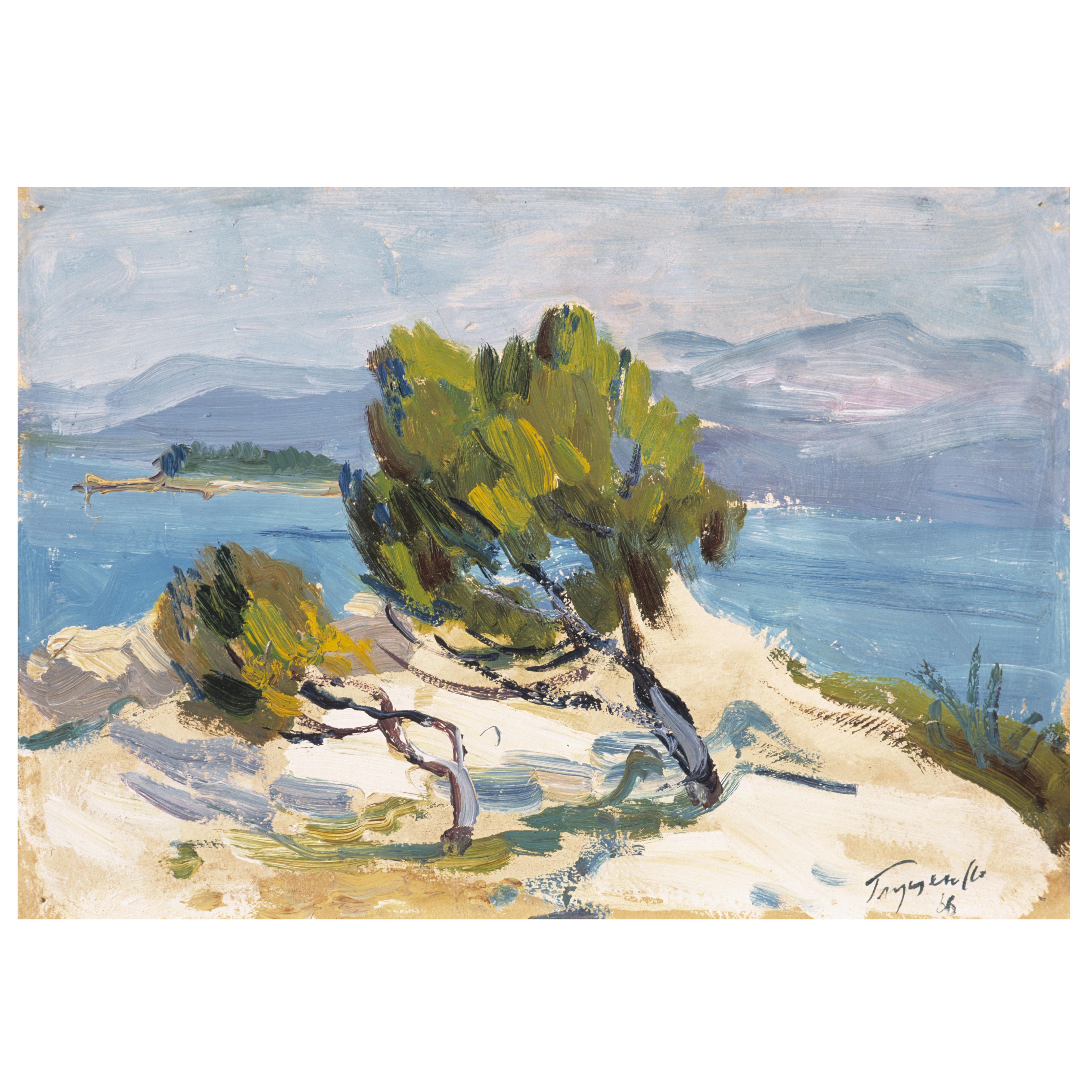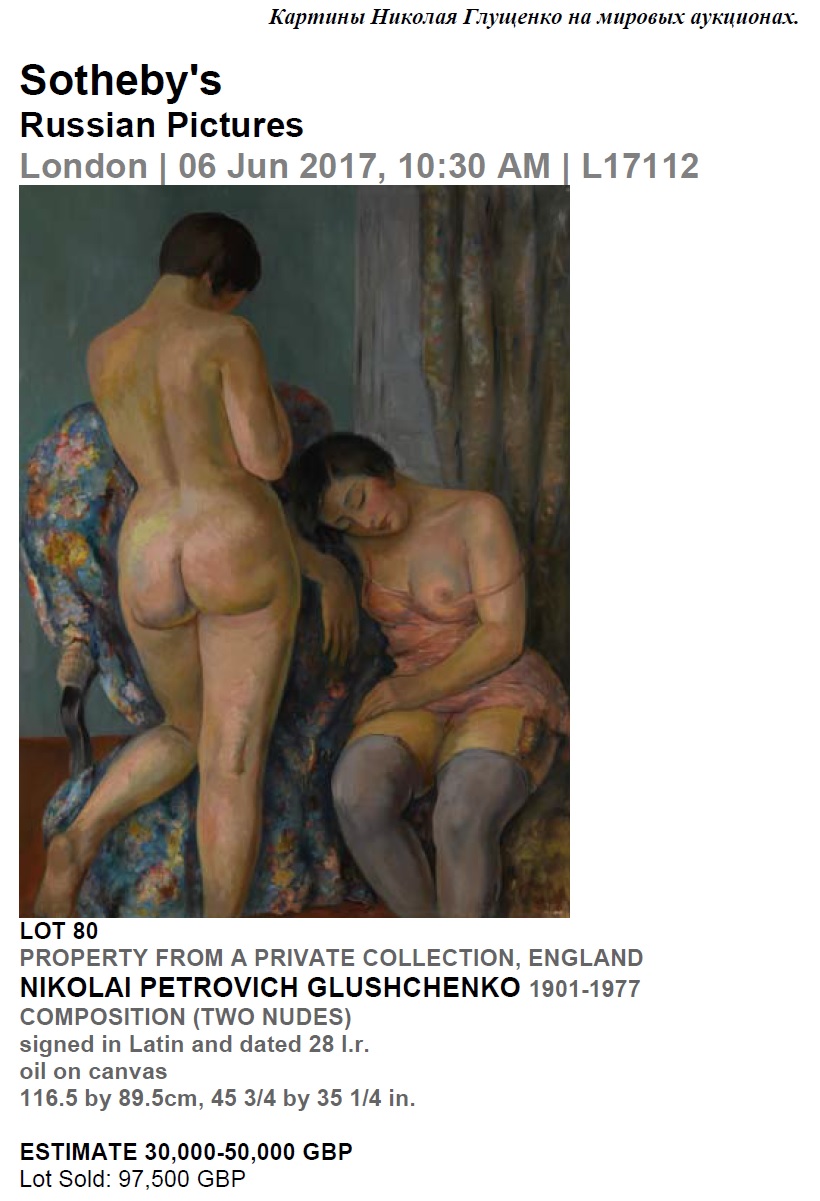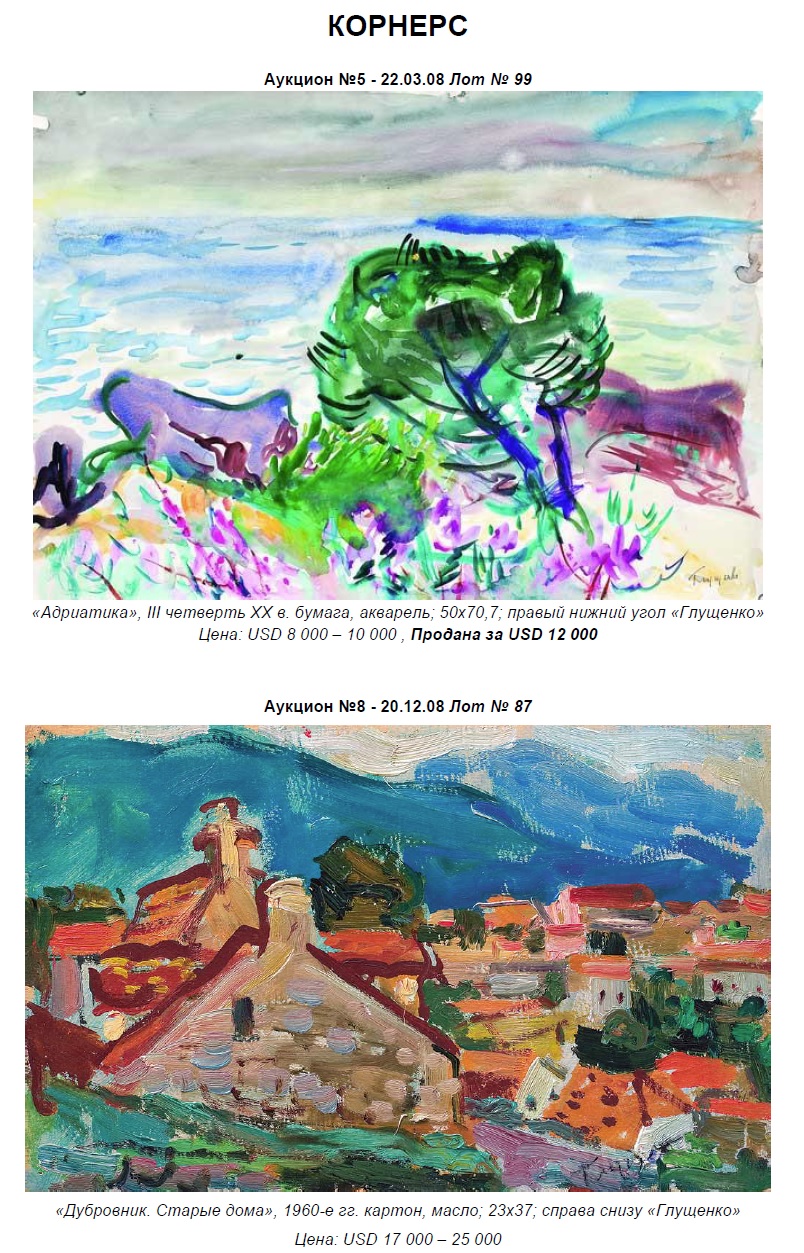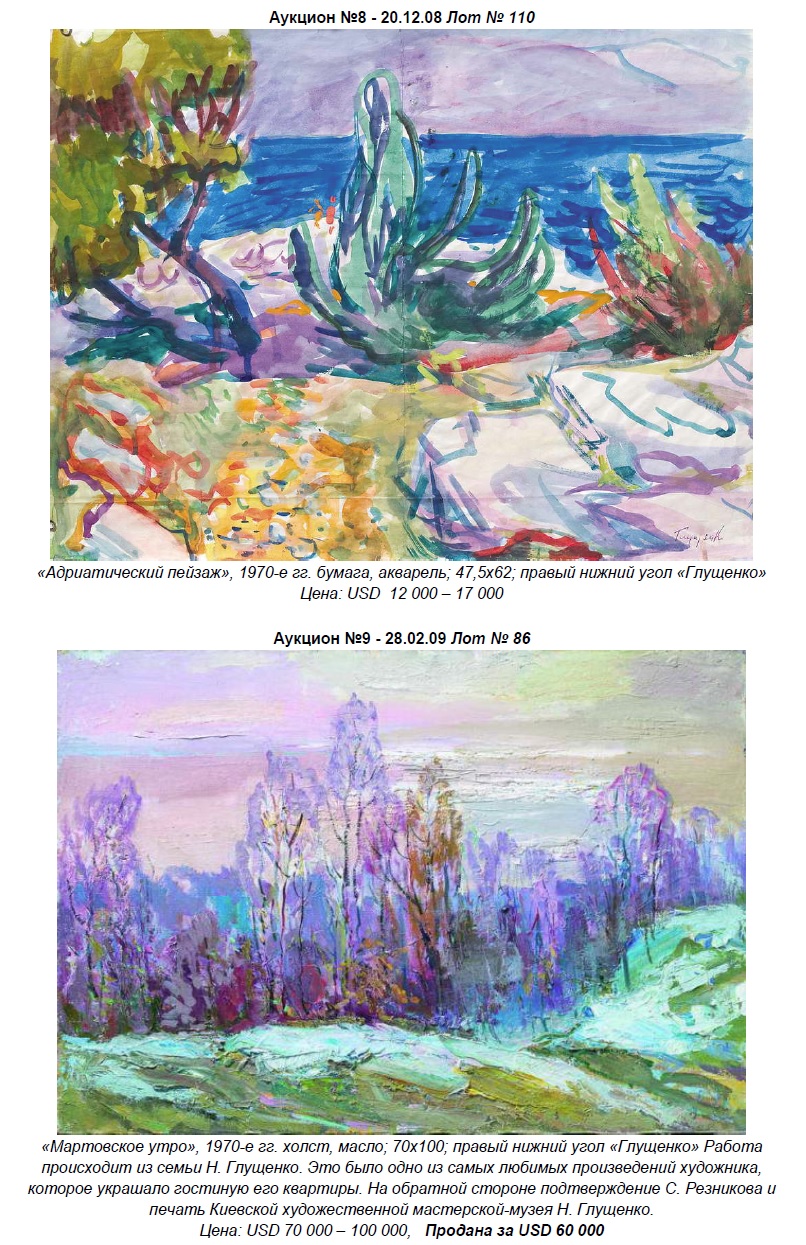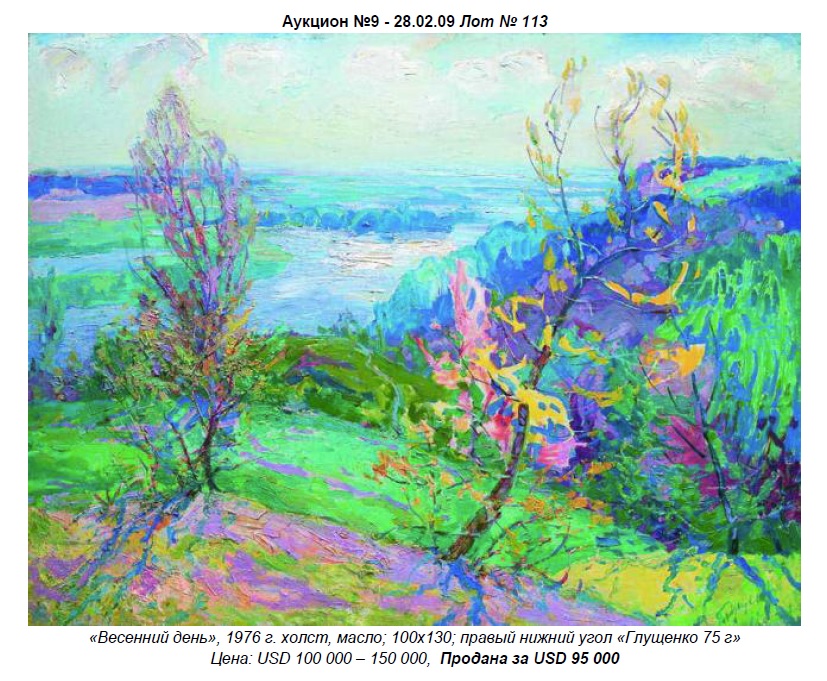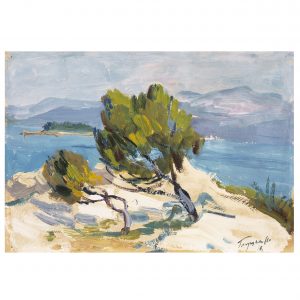GLOUTCHENKO (GLUSHENKO, GLUSHCHENKO) NICOLAS PETROVICH (1901 – 1977)
Nikolai Glushchenko has been not only one of the most prominent Soviet Ukrainian artists during his lifetime, but he also remains highly recognised posthumously. He was an intelligent, greatly talented, sophisticated aesthete, who was absorbing new trends in art and able to maintain amicable relations with quite diverse people. Glushchenko was not only an outstanding artist but also, by virtue of his courage and keen mind, he worked for the Soviet intelligence. He began his artistic career during working in the Neue Sachlichkeit style (New Objectivity), the German modernist movement associated with the movement of Realism in the 1920s, during his Berlin period. Then, after encountering the artistic scene in Paris, Glushchenko was fascinated by post-impressionism. One of his favourite genres was the landscape. Many French, Italian, Dutch and Ukrainian landscapes were repeatedly created during the artist’s lifetime. He also was often attracted to still life, nude, and portraiture.
The artist was born in a small town with rich traditions of Cossacks, Novomoskovsk, Russia, close to Yekaterinoslav (now Dnipro) on September 17, 1901. He spent his childhood in the village of Borisovka. The artist considered as one of the brightest and simultaneously first artistic memories of that period his acquaintance with the process of creating icons. The boy witnessed the work of iconographers and how a new icon is created step by step. In his youth, he moved to Yuzovka (Donetsk), where he began to take his first movements towards the development of his ability to draw. Glushchenko was taking drawing classes at the commercial school. At that time, the artist especially admired the works of Repin and Vasilkovsky.
After graduating from school, in 1918, during the troubled and difficult times of revolutionary events in Ukraine, Glushchenko joined the Ukraine army. When the army was defeated, he, with the survivors of the White movement, was captured and taken to a Polish camp for internees. Glushchenko was able to escape to Germany in 1919, without any documents or livelihood. Luckily for the young artist, wealthy and influential Ukrainian emigrants came to the rescue. For instance, hetman P. Skoropadsky, the representative of the Ukrainian People’s Republic in Berlin, has noticed Glushchenko’s extraordinary gift for drawing as well as his curious mind and sponsored the young artist’s studies in the private art school of Hans Baluschek. At this time Glushchenko is familiarising himself with the works of German artists Käthe Kollwitz and Adolf von Menzel. Glushchenko continued his education at the private school of Professor Arthur Kampf. Essentially, while being in Berlin, Glushchenko has made useful acquaintances and acquired a lot of beneficial connections. For example, the writer and film director O. Dovzhenko, who at that moment served at the Consulate of the USSR, later helped the artist to obtain a Soviet passport and introduced Glushchenko to V. Vinnichenko, who assisted the organisation of the first solo exhibition of Glushchenko in Berlin. In 1921, Glushchenko enrolled in the Academy of Arts, where he successfully completed his artistic education in 1924. It was the period when the young artist was particularly influenced by the works of the famous Swedish artist Anders Zorn. Glushchenko was acknowledged by the German art critics as early as in 1924 when several of his paintings were sent to the Kasper Art Gallery. One of the critics wrote that ‘his portraits both in terms of execution and artistic means brightly show that this is an outstanding talent with a great intellectual-aesthetic complex’.
In the manner of countless other artists before him, Glushchenko decided to relocate to the artistic Mecca, to Paris. Thus, in 1925, Glushchenko moved to the city that astonishes the artist with its artistic tendencies and inspires him to reach a new level in his art. The impact of impressionism and especially Monet and Degas, post-impressionism and one of its most renowned representatives Vincent van Gogh, and, indeed, the followers of Fauvism like Matisse, Vlaminck and Derain, could not have been ignored by Glushchenko. The artist also greatly admired the works of the English artist J. M. W. Turner. Fortune had favoured Glushchenko, and the success has come promptly enough to his career. The artist was soon able to attract the approval of the French art critics. He exhibited in the most prestigious galleries in Paris such as Salon d’automne, Salon des Independants, and the Salon des Tuileries. His paintings were honoured to be displayed alongside works by Picasso, van Gogh and Matisse. In 1925, Glushchenko helped to decorate the Soviet pavilion at the exhibition in Lyon. As one of the leading artists of the USSR, he assisted with the organisation of Soviet expositions at international exhibitions in Brussels, Milan, Paris, and Marseille. He participated in the arrangement of exhibitions of Soviet artists in Paris, including an exhibition of Peter Konchalovsky. Glushchenko was always in the spotlight: an athletic, charming, proficient in conversations at the social gatherings, bright young man. The artist opened his art studio in Paris which was reminiscent of a cultural salon. He regularly gathered the most diverse audience in there: Parisians, tourists, former compatriots, intellectuals, government officials, leaders of Ukrainian foreign organisations. Even the Austro-Hungarian Archduke Wilhelm von Habsburg, a nephew of former Austrian Emperor Franz Joseph, was a frequent guest of this establishment. Consequently, in 1926, the studio was visited by the Soviet intelligence officers, who had found that Glushchenko’s personality, his lifestyle and circle are suitable for their purposes. Thus, the artist has started to gather information for the Soviet Union. Some portraits, which Glushchenko painted since then, were ordered by the Soviet government as part of the artist’s intelligence.
Glushchenko was a very socially active artist, and he concentrated not only on his art but also on the public artistic events. In the early 1930s, Glushchenko was a member of the Association of Independent Artists of Ukraine and participated in the organisation of a large-scale exhibition of Ukrainian, French and Italian works in the National Museum of Lviv. In 1934, he made a creative trip to Spain: the Balearic Islands and Mallorca. Influenced by Communist ideas, in 1936 the artist moved to Moscow. At the first opportunity, the artist was visiting his beloved Ukraine and focused on his painting of the surrounding landscape. He was permitted to live in Ukraine only after the war when his work began to reflect the officially accepted artistic direction of Socialist Realism. In 1944, the artist finally moved to Kiev. In the 1960s, contacts with Western countries, trips abroad and familiarity with new artistic trends eventually were settled in Glushchenko’s work as the entire new stage of his career. He revived his paintings with expressive colours and took a leading position among Ukrainian colourists. There were thirty-two solo exhibitions during the artist’s lifetime. More than ten exhibitions were held in Kyiv alone. Glushchenko’s works were exhibited in Berlin in 1924, in Paris there were 5 exhibitions of the artist from 1925 to 1934, in Milan in 1927, in Ostend in 1927, in Budapest in 1930 and 1932, in Stockholm in 1931, in Rome in 1933, in Lviv in 1934 and 1935, in Moscow in 1943 and 1959, in Belgrade in 1966 and 1968, in London in 1966, in Toronto in 1967 and 1969. In the 1970s, the artist became interested in the technique of monotype. Glushchenko died on October 31, 1977, in Kyiv. The artist left more than ten thousand works that are scattered around the world in private collections and museums in Russia, Ukraine, Germany, France, Canada and the USA.
